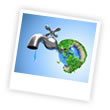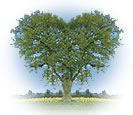How much water is there on Earth?

Up until a few decades ago, people used to think that water was a practically inexhaustible resource, whereas today we all know only too well that it precious and in limited supply. But how much water is available to us? The answer is approximately 1,390 million cubic km, of which 97.5% is salt water located in the seas and oceans and only 2.5% is theoretically drinkable.
This already limited quantity is further reduced by approximately 90% if we discount the water contained in the polar icecaps. We therefore arrive at a total of approximately 93,000 cubic km, or about 0.25% of the total water on the planet. A drop… in the ocean!
In the twentieth century, world annual consumption of potable water grew from 300 cubic km to 2,100 cubic km. Annual per capita water use varies considerably in the different parts of the world: North Americans use 1,280 cubic metres, Europeans around 700 cubic metres and Africans just 185 cubic metres. Increases in world population means increased water consumption but less availability of water per capita.
In 1989 there were 9,000 cubic metres of freshwater available per person. By 2000 this figure had dropped to 7,800 cubic metres and it is predicted to plummet to just above 5,000 cubic metres by 2025. Global consumption of water is doubling every 20 years, more than twice the rate of human population growth. It is calculated that the world’s population is currently using 54% of all the freshwater available from rivers, lakes and underground aquifers. By 2025 this percentage will reach 70% and may rise to 90% within a few years, unless we all start doing something about it, by saving water!
(data taken from the website http://www.lenntech.com/specific-questions-water-quantities.htm)





